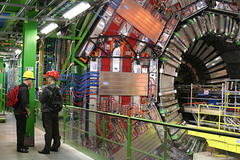One of the greatest ironies of physics is that to see the smallest things in the Universe we need huge machines. The Compact Muon Solenoid detector (or just CMS for short) is one of two extremely complex - and very, very large - pieces of equipment used by CERN’s Large Hadron Collider (LHC) in Geneva to sift through the bits of shrapnel created when packets of protons smash into each at very nearly the speed of light.
Just how big is the CMS? BABloggee Thomas Radke sent me this picture of it.
Click it to see the original 6000 pixel picture hosted at CERN. Then pick your jaw up from the floor. This monstrosity is 15 meters high - nearly 50 feet! To give you a sense of the scale here, look to the bottom of the green scaffolding on the sides, and you’ll see handrails where people can stand.
 I visited the LHC a few years back, thanks to Brian Cox who brought me there for a tour and interview. This was shortly before the gigantic machine was switched on, so we went down 100 meters below the Earth’s surface to take a look. I stood off to one side of the CMS, and the scale of it was hard to grasp. It’s over 20 meters long, and weighs over 12,000 tons - 24 million pounds! A lot of that weight is from the huge slabs of iron you can see painted red.
I visited the LHC a few years back, thanks to Brian Cox who brought me there for a tour and interview. This was shortly before the gigantic machine was switched on, so we went down 100 meters below the Earth’s surface to take a look. I stood off to one side of the CMS, and the scale of it was hard to grasp. It’s over 20 meters long, and weighs over 12,000 tons - 24 million pounds! A lot of that weight is from the huge slabs of iron you can see painted red.
I made a video during my LHC visit, and the CMS part is about five minutes into it.
Yeah. That’s the kind of stuff we do when we want to pry open the seams of the Universe and peek inside.
Image credit: CERN
Related Posts:
- Higgs!
- My excellent CERN adventure: the video
- CERN podcast with Brian Cox and me
- LHC update: it’s now all-powerful